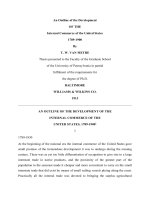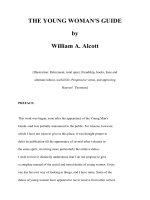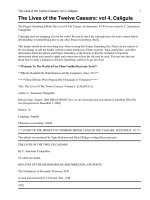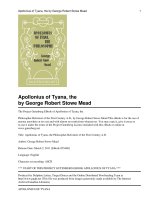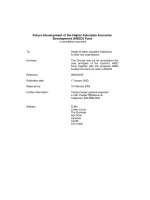Development of the Industrial U.S. Biographies pot
Bạn đang xem bản rút gọn của tài liệu. Xem và tải ngay bản đầy đủ của tài liệu tại đây (5.1 MB, 287 trang )
Development of
the Industrial U.S.
Biographies
Development of
the Industrial U.S.
Biographies
Sonia G. Benson
Carol Brennan,
Contributing Writer
Jennifer York Stock,
Project Editor
Development of the Industrial U.S: Biographies
Sonia G. Benson
Project Editor
Jennifer York Stock
Editorial
Sarah Hermsen
Rights Acquisitions and Management
Shalice Shah-Caldwell, Kim Smilay
Imaging and Multimedia
Randy Bassett, Lezlie Light,
Daniel Newell, Denay Wilding
Product Design
Pamela A. E. Galbreath
Composition
Evi Seoud
Manufacturing
Rita Wimberly
ª 2006 Thomson Gale, a part of
The Thomson Corporation.
Thomson and Star Logo are trademarks
and Gale is a registered trademark
used herein under license.
For more information, contact:
Thomson Gale
27500 Drake Rd.
Farmington Hills, MI 48331-3535
Or you can visit our Internet site at
ALL RIGHTS RESERVED
No part of this work covered by the
copyright hereon may be reproduced or
used in any form or by any means—
graphic, electronic, or mechanical,
including photocopying, recording,
taping, Web distribution, or
information storage retrieval systems—
without the written permission of
the publisher.
For permission to use material from
this product, submit your request via
the Web at />permissions, or you may download our
Permissions Request form and submit
your request by fax or mail to:
Permissions Department
Thomson Gale
27500 Drake Rd.
Farmington Hills, MI 48331-3535
Permissions Hotline:
248-699-8006 or 800-877-4253, ext. 8006
Fax: 248-699-8074 or 800-762-4058
Cover photographs of J. P. Morgan,
ª Corbis; Samuel Slater, ª Bettmann/
Corbis; Jane Addams, courtesy of The
Library of Congress.
While every effort has been made to
ensure the reliability of the information
presented in this publication, Thomson
Gale does not guarantee the accuracy of
the data contained herein. Thomson
Gale accepts no payment for listing; and
inclusion in the publication of any
organization, agency, institution,
publication, service, or individual does
not imply endorsement by the editors
or publisher. Errors brought to the
attention of the publisher and verified
to the satisfaction of the publisher will
be corrected in future editions.
Printed in the United States of America
10987654321
LIBRARY OF CONGRESS CATALOGING-IN-PUBLICATION DATA
Benson, Sonia.
Development of the industrial U.S. Almanac / Sonia G. Benson ; Jennifer York Stock,
project editor.
p. cm.
Includes bibliographical references and index.
ISBN 1-4144-0175-2 (hardcover : alk. paper)
1. Industries–United States–Biography–Juvenile literature. 2. Industrial revolution–
United States–Biography–Juvenile literature. [1. United States–Economic conditions–
To 1865–History–Juvenile literature.] I. Title: Development of the industrial US. II.
Stock, Jennifer York, 1974- III. Title.
HC102.5. A2.B46 2006
338. 092’273–dc22 2005016350
Table of Contents
Introduction . . . . . . . . . . . . . . . . vii
Reader’s Guide . . . . . . . . . . . . . . . xiii
Timeline of Events . . . . . . . . . . . . . . xvii
Words to Know . . . . . . . . . . . . . . xxix
Jane Addams . . . . . . . . . . . . . . 1
Caroline Webster Schermerhorn Astor . . . . 10
Alexander Graham Bell . . . . . . . . . 21
Andrew Carnegie . . . . . . . . . . . 30
Chinese Transcontinental
Railroad Workers . . . . . . . . . . . 40
Eugene Victor Debs . . . . . . . . . . 49
Thomas Edison . . . . . . . . . . . . 60
John Fitch . . . . . . . . . . . . . . 71
Henry Ford . . . . . . . . . . . . . 79
Frank and Lillian Gilbreth . . . . . . . . 89
Florence Kelley . . . . . . . . . . . . 100
Robert M. LaFollette . . . . . . . . . . 109
v
Julia C. Lathrop . . . . . . . . . . . . 120
Lewis H. Latimer . . . . . . . . . . . 128
Mary Elizabeth Lease . . . . . . . . . . 136
Francis Cabot Lowell . . . . . . . . . . 144
Elijah McCoy . . . . . . . . . . . . . 154
J. P. Morgan . . . . . . . . . . . . . 162
George Washington Murray . . . . . . . 176
A. Philip Randolph . . . . . . . . . . . 182
John D. Rockefeller Sr. . . . . . . . . . 193
Samuel Slater . . . . . . . . . . . . . 207
Ellen Gates Starr . . . . . . . . . . . . 215
Ida M. Tarbell . . . . . . . . . . . . 223
Cornelius Vanderbilt . . . . . . . . . . 234
Booker T. Washington . . . . . . . . . 244
Where to Learn More . . . . . . . . . . . . xxxix
Index xli
vi Development of the Industrial U.S.: Biographies
Introduction
I
ndustrialization is the widespread development of profit-
making businesses that manufacture products on a large
scale, using labor-saving machinery. Understanding the his-
tory of the development of industrialization in the United
States, which took place over two centuries, involves learning
about some of its technical elements, such as technology and
the economy. But the history of U.S. industrialism is also a
dramatic story of people rising and falling from power or
struggling desperately to make the world a better place.
Industrialization fueled the national culture, economy,
daily life, and politics, creating such tremendous social
changes that it is impossible to imagine what life in the
United States would be like without it.
Though the Industrial Revolution, a period of rapid indus-
trial growth causing a shift in focus from agriculture to indus-
try, first began in England and Europe in the middle of the
eighteenth century, industrialization did not begin to take root
in the United States until after the American Revolution
(1775–83). Even then American industrialization had a slow
start, due to overwhelming obstacles. At the time, the vast
vii
majority of Americans lived independent lives as farmers in
remote areas. For the most part, they had little connection with
anyone but neighboring farmers, since there were few good
roads or systems of communication. Most people did not even
own clocks; time was determined by the seasons and the rising
and setting of the sun. Few people worked for wages, and those
manufactured goods Americans could afford generally came
from Europe. The new nation had vast natural resources, such
as land, timber, metals, minerals, water power, and ports, but
without transportation or manufacturing it was nearly impos-
sible to make industrial use of them.
Once begun, the American Industrial Revolution took on
its own character, differing from that of other countries. This
was primarily because Americans themselves had been shaped
and selected by a unique set of forces. After fighting hard to
gain independence from England, most Americans were pas-
sionate about the ideals of liberty and equality for all (although
to many Americans at the time this meant only white males),
and they were determined to create a society in which any
individual could rise and prosper through his or her own
efforts. They were also driven by the desire for wealth.
Though many Europeans immigrated to America to find reli-
gious or social freedom, the majority came seeking riches.
Many had faced bitter hardships and were prepared to take
major risks to obtain wealth. Another key trait of Americans
was a spirit of innovation; it had been a necessary attribute for
emigrants who left Europe in the seventeenth century, for they
would have to reinvent the most basic aspects of their daily
lives in the New World. The combined spirit of individualism,
greed, and innovation came to characterize U.S. industrialism.
In the years between the American Revolution and the
American Civil War (1861–65), innovation and invention were
highly esteemed by the American public. Most industrial
designs and ideas came initially from Europe, but once they
reached the machine makers, or ‘‘mechanicians,’’ of American
shops, they were improved until they became distinctly
American, suited to the land and its people. The times produced
an extremely talented group of inventors and innovators, and
from their workshops, which were mainly located in the north-
eastern United States, the ‘‘American System,’’ or mass produc-
tion and the use of interchangeable parts, emerged. It would
forever change the nature of manufacturing worldwide.
viii Development of the Industrial U.S.: Biographies
With new advances in technology, some enterprising busi-
ness people built the first U.S. factories, and most of them
flourished. However, from the start the stark division in wealth
and position between industry owners and their workers was at
odds with the popular belief in American liberty and equality.
Despite early factory owners’ efforts to humanize factory work,
workers faced low wages and poor working conditions. Many
claimed they were slaves to wage labor. It was not long after the
first industrial workforces were hired that the first labor strikes
took place. The conflict between employers and employees
continued, and the factory owners’ early attempts to create
ideal circumstances for workers were abandoned. Professional
managers were hired to get as much work from the workforce
as possible. A huge influx of immigrants from Europe and Asia
from the 1840s until the 1920s supplied inexpensive labor, but
labor strikes continued.
After a slow beginning in the Northeast industrialization
began to spread at a rapid pace with the nationwide building of
transportation and communications systems. The construc-
tion of the transcontinental railroad spanning the nation
from one coast to the other—a mammoth undertaking—sig-
naled the start of a new way of life for all Americans. Where
railroads went, towns and cities with bustling new commerce
arose. The construction of the railroads spawned giant new
industries in steel, iron, and coal. Railroads brought farmers’
crops to distant markets and were instrumental in bringing the
industrial society to the West.
For the railroads to be built and industry to advance,
capital, or vast quantities of money, was required. The art
of raising large amounts of capital and applying it to industry
was mainly accomplished by a generation of extremely cap-
able industrialists who built the gigantic industries that
dominated the nation and ruled its economy. These legend-
ary men, admired as the ‘‘captains of industry’’ by some and
loathed as ruthless crooks, or ‘‘robber barons,’’ by others,
included railroad owner Cornelius Vanderbilt, steel empire
founder Andrew Carnegie, Standard Oil tycoon John D.
Rockefeller, investment banker J. P. Morgan, and many
others. Though some of them came from wealthy back-
grounds, many were born in humble circumstances and
rose to wealth and power through their own efforts. These
industrialists created new systems of doing business that are
Introduction ix
still in place today. Their tactics almost always included
creating monopolies, huge corporations that dominated
their industry nationwide and limited attempts at competi-
tion by others. As the industrialists prospered, most of the
wealth of the nation fell into their hands. This period became
known as the Gilded Age, the era of industrialization from
the early 1860s to the turn of the century in which a few
wealthy individuals gained tremendous power and influence.
During the Gilded Age the power of industrialists and their
corporations seemed unstoppable.
The number of U.S. companies dwindled from thousands
to hundreds as the most powerful industrialists bought out or
crushed their competitors. Once again, the national spirit of
liberty and equality was aroused. Farmers, laborers, poor
immigrants, and labor unions as well as middle class refor-
mers sought relief from the power of the corporations, giving
rise to the Progressive Era, or the period of the American
Industrial Revolution that spanned roughly from the 1890s
to about 1920, in which reformers worked together in the
interest of distributing political power and wealth more
equally. It was during this time that the strong hand of the
federal government was finally felt in American industry, as it
began to leave behind its laissez-faire, or non-interference,
policies in order to regulate businesses, curb monopolies,
and protect workers.
By the twentieth century, the United States was the richest
and most powerful industrial nation in the world, but the
process of industrialization continued. During the twentieth
century industry was shaped by scientists like Frederick
Winslow Taylor, who devised measurable methods of business
management designed to produce top levels of efficiency. The
best-known follower of ‘‘Taylorism’’ was Henry Ford, who
began to mass produce affordable automobiles in 1909. The
Great Depression (1929–41) and World War II (1939–45) both
had profound effects on American industrialism, causing gov-
ernment controls and assistance to individuals to increase even
more. In recent decades, computers and globalism have been
the active agents of change in U.S. industrialism.
Finally, it is worthwhile to note that the development of
U.S. industrialization is not finished. It took more than one
hundred years for the United States to transform from a
x Development of the Industrial U.S.: Biographies
farming society to an industrial world power. Adjusting to
industrialism has already taken up another century and will
continue for many years to come.
Sonia G. Benson
Introduction xi
Reader’s Guide
T
he United States began as a nation of farmers living in
remote areas, but over a period of two hundred years the
country became the wealthiest and most powerful industrial
nation of the world. During the American Industrial
Revolution inventors and innovators created new and
improved machines for manufacturing, while a new breed
of American businessmen created revolutionary methods of
conducting business and managing labor. The road to indus-
trialization was not always heroic. Ruthlessness and greed
were often key ingredients in advancing industry. While a
few found wealth and power, multitudes of workers and
farmers suffered, and small businesses were crushed by the
powerful new corporations. Reformers, unions, and protes-
tors against big business played a crucial role in the indus-
trialization process as they pressed for the rights of workers
and regulations on business to help farmers and consumers.
The diverse people and events that forever changed the
nation from a rural farming economy to an industrialized
urbannationcreateadramaticstory that lies at the heart of
U.S. history.
xiii
Coverage and features
Development of the Industrial U.S.: Biographies profiles
twenty-six significant figures who participated in American
industrialization. The biographies cover a wide spectrum of
people, from the creators of the first factories, such as Samuel
Slater and Francis Cabot Lowell, to inventors and innovators,
including John Fitch, Elijah McCoy, and Thomas Edison.
Industrialists Andrew Carnegie, J. P. Morgan, and John D.
Rockefeller are profiled, as are reformers and educators such
as Jane Addams, Florence Kelley, and Booker T. Washington.
Biographies also includes labor advocates such as Eugene Debs
and A. Philip Randolph. The volume features more than fifty
photographs and illustrations, a timeline, a glossary, and
sources for further reading.
U
X
L Development of the Industrial U.S. Reference
Library
Development of the Industrial U.S.: Biographies is only one
component of the three-part U
X
L Development of the
Industrial U.S. Reference Library. The other two titles in this
set are:
Development of the Industrial U.S.: Almanac presents an over-
view of the history of American industrialization. Its four-
teen chapters cover the first American factories, inventors,
the rise of big business and railroads, urbanism, labor
unions, industrial influences in places such as the South
or the Great Plains, the Gilded Age, the Progressive Era, the
post-industrial era, and much more. Each chapter of the
Almanac features informative sidebar boxes highlighting
glossary terms and issues discussed in the text and con-
cludes with a list of further readings. Also included are
more than sixty photographs and illustrations, a timeline,
a glossary, a list of suggested research and activity ideas,
and an index providing easy access to subjects discussed
throughout the volume.
Development of the Industrial U.S.: Primary Sources presents
eighteen full or excerpted written works, speeches, and
other documents that were influential during American
industrialization. The volume includes excerpts from the
writings of Thomas Jefferson and Alexander Hamilton
reflecting their debate on industrialization; excerpts from
xiv Development of the Industrial U.S.: Biographies
legislation regarding industrialization, such as the
Interstate Commerce Act and the Sherman Antitrust Act;
segments of popular novels by Horatio Alger and William
Dean Howells depicting the effects of industrialization on
American society; political cartoons; a popular labor song;
an excerpt from an essay by William Graham Sumner pre-
senting the concept of social Darwinism, and much more.
Nearly fifty photographs and illustrations, a timeline,
sources for further reading, and an index supplement the
volume.
A cumulative index of all three volumes in the U
X
L
Development of the Industrial U.S. Reference Library is also
available.
Comments and suggestions
We welcome your comments on Development of the
Industrial U.S.: Biographies and suggestions for other topics in
history to consider. Please write: Editors, Development of the
Industrial U.S.: Biographies, U
X
L, 27500 Drake Rd.,
Farmington Hills, Michigan, 48331-3535; call toll-free: 1-800-
877-4253; fax to: 248-699-8097; or send e-mail via http://
www.gale.com.
Reader’s Guide xv
Timeline of Events
1780: American mechanics in the Northeast begin to apply
principles learned from the English Industrial
Revolution in their innovations on tools and machines.
1781: Oliver Evans invents machines to replace human labor
in flour mills.
1787: John Fitch demonstrates the first working steamboat
to potential investors.
1789: Samuel Slater arrives in the United States with detailed
knowledge of English textile machines and helps
found the U.S. textile industry.
1775–83
American
Revolution
1776
Adam Smith
publishes Wealth
of Nations
1789
French Revolution
begins
xvii
1775 1780 1785 1790
1790: Eighty percent of the nation’s population is made up of
farmers and ninety-five percent of the population lives
in rural areas.
1790: Congress passes the first patent law.
1798: Eli Whitney proposes to make 4,000 muskets for the
U.S. government, using new machine-making tools
and interchangeable parts.
1807: Robert Fulton’s steamboat, the Clermont, makes its
maiden voyage from New York City to Albany, New
York.
1807: Eli Terry builds four thousand clockworks on a tight
schedule using the latest principles of mass
production.
1814: Francis Cabot Lowell opens the first textile factory
that incorporates spinning and weaving under one
roof in Waltham, Massachusetts.
1817: Congress authorizes the construction of the National
Road, the first road to run west across the Appalachian
Mountains.
1817–1825: The Erie Canal is built, connecting Albany and
Buffalo, New York.
1825: The New York Stock Exchange opens its new headquar-
ters at 11 Wall Street.
1826: The first U.S. railway, the Baltimore and Ohio (B & O) is
launched.
1831: Cyrus McCormick invents the first workable reaper.
1836: Two thousand women workers go on strike for better
wages and conditions at the Lowell textile mills.
1807
London becomes
the first city with
gas street lights
1819
Canning industry
begins in
America
1828
Russo-Persian
War ends
1838
Northern
abolitionists
organize the
Underground
Railroad
xviii Development of the Industrial U.S.: Biographies
1795 1810 1825 1840
1837: John Deere invents the steel plow.
1840: The Lowell Offering, a journal written by the women
workers of the Lowell mills, is launched.
1840s: Immigration to the United States from Europe increases
significantly. Between 1840 and 1920 37 million immi-
grants will arrive in the country.
1844: Samuel F. B. Morse sends the first official telegraph
message from Washington, D.C., to Baltimore,
Maryland.
1846: Elias Howe patents his sewing machine. Isaac M. Singer
will market a more practical sewing machine within
four years.
1851: U.S. technology exhibits impress visitors at the Crystal
Palace Exhibition of London, the first world’s fair.
1852: Samuel Colt opens a large arms manufacturing factory,
using advanced mass-production techniques.
1859: The first successful effort to drill for oil gives rise to the
oil industry.
1860: Shoemakers in Lynn, Massachusetts, launch a massive
strike for better wages and working conditions. The strike
will spread to factories over a wide area and include as
many as twenty thousand men and women workers.
1862: The Pacific Railroad Act calls for building a transconti-
nental railroad from Omaha, Nebraska, to Sacramento,
California.
1862: Congress enacts the Homestead Act, which provides
small pieces of public land to settlers in the West for
farming; industry soon expands into the new
territories.
1847
Marx and Engels
publish the
Communist Manifesto
1850
Taiping Rebellion begins
in China
1859
John Brown leads a raid on
Harper’s Ferry
Timeline of Events xix
1845 1850 1855 1860
1864: The first Bessemer converter, a new process for making
steel, is introduced in the United States.
1865: John D. Rockefeller opens an oil refinery in
Cleveland, Ohio.
1866: The National Labor Union (NLU) is formed to promote
the eight-hour workday.
1867: In the first cattle drive, organized by James G. McCoy,
cattle are driven from Texas to Abilene, Kansas, where
they are shipped by railroad to Chicago, Illinois.
1867: The National Grange of the Patrons of Husbandry
(usually called the Grange) is founded to advance the
interests of farmers.
1867: Chinese transcontinental railroad workers represent
between 80 and 90 percent of the Central Pacific
Railroad workforce building the western portion of
the transcontinental railroad.
1867–1868: Cornelius Vanderbilt clashes with Daniel Drew,
Jay Gould, and James Fisk for ownership of the Erie
Railroad in a competition that became known as the
Erie War.
1869: The two railroad companies, the Union Pacific and the
Central Pacific, commissioned to build the transconti-
nental railroad meet at Promontory Point, Utah, mark-
ing the completion of the first transcontinental
railroad.
1869: The Knights of Labor, one of the early national labor
unions, is founded.
1869: On September 24 or ‘‘Black Friday,’’ the price of gold fell
due to the speculations of James Fisk and Jay Gould,
creating a financial panic.
1865
American Civil War ends
1868
Meiji Restoration
begins in Japan
1870
Franco-Prussian
War begins
xx Development of the Industrial U.S.: Biographies
1865 1867 1869 1871
1869 A fire in the Avondale coal mine in Pennsylvania kills
108 men and boys.
1872: Hunters and railroad workers have killed millions of
buffalo on the Great Plains, reducing their numbers
from 15 million to 7 million. The extermination will
continue until less than one thousand buffalo remain
in the 1890s.
1872: Mrs. Astor meets Ward McAllister, and together they
create a New York City institution that will set the tone
for high society for years to come: Mrs. Astor’s annual
ball.
1872: Elijah McCoy patents his invention, a special lubricat-
ing cup that can be fitted into the steam cylinders of
locomotives, speeding up railroads nationwide. The
device will come to be known as ‘‘the real McCoy.’’
1873: One of the nation’s largest banks, owned by Jay Cooke,
fails, causing business failures and unemployment. A
nationwide depression follows.
1875: The National Farmers’ Alliance is founded. It quickly
divides into two groups, the Northern Alliance and the
Southern Alliance.
1877: A large railroad strike begins in West Virginia to protest
wage reductions. Within a few weeks, it spreads
throughout the nation with about ten thousand parti-
cipating workers. More than one hundred are killed by
federal troops and about one thousand are jailed before
the Great Strike is suppressed.
1877: Alexander Graham Bell and Thomas Watson have the
first telephone conversation, transmitted over wire
from New York City to Boston, Massachusetts.
1875
Civil Rights Act of 1875 is
enacted
1876
Battle of Little Bighorn
1881
Clara Barton founds the
Red Cross
Timeline of Events xxi
1873 1876 1879 1882
1881: Andrew Carnegie forms Carnegie Steel Company by
combining his own successful steel company with sev-
eral others.
1881: Booker T. Washington opens the Tuskegee Normal
and Industrial Institute, an industrial school for
African American students in Alabama.
1882: Thomas Edison’s Pearl Street electrical station supplies
power to four hundred incandescent light bulbs owned
by eighty-five customers in New York City.
1886: The Haymarket Riots erupt in Chicago, pitting striking
workers against police.
1886: The American Federation of Labor (AFL) reorganizes
under the leadership of Samuel Gompers as a federa-
tion of trade unions formed to improve wages and
working conditions, shorten working hours, abolish
child labor, and provide for collective bargaining.
1886: The Colored Farmers’ Alliance is founded.
1887: Congress passes the Interstate Commerce Act to regu-
late the railroads. It is the first regulatory act designed
to establish government supervision over a major
industry.
1888: Jane Addams and Ellen Gate Starr found Hull House,
a settlement house in Chicago.
1889: James Buchanan Duke merges his tobacco company
with four others to create the American Tobacco
Company, controlling 90 percent of the U.S. tobacco
industry.
1890: Congress enacts the Sherman Antitrust Act to prohibit
companies from restricting competition or creating
monopolies.
1883
American railroads adopt
standard time zones
1886
Statue of Liberty is dedicated
in New York Harbor
1890
Battle of Wounded Knee
xxii Development of the Industrial U.S.: Biographies
1883 1886 1889 1892
1890: The People’s Party, better known as the Populists, is
formed to combine the interests of farmers in the
South and West and laborers nationwide to combat
the powers of the Eastern industrialists. Mary
Elizabeth Lease becomes a stump speaker for the
party, giving hundreds of speeches around the
country.
1892: In the Homestead Strike, the workers at Andrew
Carnegie’s steel mills strike to protest low wages and
the hiring of nonunion workers. A violent battle
ensues, and the union in the steel mills is crushed.
1893: A financial panic, mainly due to the collapse of hun-
dreds of railroad companies, results in a nationwide
depression.
1890: Lewis Lattimer publishes Incandescent Electric Lighting:
A Practical Description of the Edison System, a ground-
breaking book on electric lighting.
1894: When the workers at the Pullman factory go on strike
for better wages, 125,000 railroad workers in the
American Railway Union (ARU), under the leadership
of Eugene Debs, join the strike to support the Pullman
workers.
1895: George Washington Murray, the only black represen-
tative then in Congress, reads into the congressional
record a list of 92 patents granted to African-Americans
in an attempt to advance African American education.
1899: Florence Kelley founds the National Consumers’
League, a lobbying agency for protective labor legisla-
tion for women and children.
1900: New York City becomes grossly overpopulated, with
about 1.2 million people, or about 75 percent of its
1893
Lizzie Borden trial
1896
Supreme Court rules on
Plessy v. Ferguson
1897
First U.S. subway
line opens in Boston
Timeline of Events xxiii
1893 1895 1897 1899
population living in overcrowded tenement buildings
without adequate water, air, sewage, or garbage
removal.
1900: About 1.7 million children under the age of sixteen are
working in factories.
1900: Industrial accidents kill about 35,000 workers each
year and disable 500,000 others.
1900: African Americans begin to migrate from the South to
Northern industrial cities. By 1910, 366,880 African
Americans will migrate to Northern cities from the
South. From 1910 to 1920 between five hundred thou-
sand and one million African Americans will make the
trip north.
1900: Several U.S. magazines present a new form of journal-
ism called muckraking, which investigates corruption
in big business and government.
1900: Robert M. La Follette wins the governorship of
Wisconsin by campaigning as a champion of the peo-
ple, promising to fight big business and political
bosses.
1903: President Theodore Roosevelt creates a federal
Department of Commerce and Labor to investigate
the operations and conduct of corporations.
1903: Frederick Winslow Taylor publishes an essay about
making the workplace more efficient that will quickly
become the basis of a new movement of scientific
business management, or Taylorism.
1904: Ida M. Tarbell publishes her classic muckraking work,
History of the Standard Oil Company, which probes the
questionable tactics of the dominant oil-refining com-
pany and its owner, John D. Rockefeller.
1900
Boxer Rebellion begins in
China
1903
Wright brothers make
historic flight
1904
Construction of the Panama
Canal begins
xxiv Development of the Industrial U.S.: Biographies
1900 1902 1904 1906
1904: The U.S. Supreme Court rules that the Northern
Securities Trust, a combination of several railroads
owned in a trust under the management of James J.
Hill, Edward H. Harriman, and J. P. Morgan, is in
violation of the Sherman Antitrust Act. It is the first
major trust to be dissolved under the act.
1907: A federal law against child labor is introduced to
Congress, but it is defeated. Three years later, an esti-
mated 2 million American children are still employed
by industries.
1910: In the South, 80 percent of African American farmers
and 40 percent of white farmers are either sharecrop-
pers or tenant farmers struggling to survive.
1910: Henry Ford opens his Model T automobile factory in
Highland Park, Michigan, and begins mass producing
affordable cars.
1911: The U.S. Supreme Court rules that the Standard Oil
Trust and the American Tobacco Company are in vio-
lation of the Sherman Antitrust Act and order them to
dissolve.
1911: A fire at the Triangle Shirtwaist Company, a garment
factory, kills 146 workers, mostly poor immigrant
women and girls.
1912: Julia C. Lathrop is appointed chief of the new federal
Children’s Bureau, which will investigate child labor,
infant mortality (death), juvenile courts, and many
other aspects of children’s well-being.
1913: Frank and Lillian Gilbreth open the Summer School
of Scientific Management, which trains professionals
to teach new ideas about business management,
emphasizing the study of motion and psychology.
1910
China bans slavery
1912
The Titanic sinks
1914
World War I begins
Timeline of Events xxv
1908 1910 1912 1914
1914: Congress enacts the Clayton Antitrust Act, which
updates the Sherman Antitrust Act and includes an
important provision allowing workers to unionize
and strike.
1920: For the first time in the United States, more people live
in the city than in the country.
1925: A. Philip Randolph organizes the Brotherhood of
Sleeping Car Porters (BSCP), the first African
American union in the country to sign a labor contract
with a white employer.
1927: Charles A. Lindbergh makes his famous 2,610-mile
transatlantic (spanning the Atlantic Ocean) solo flight
from Long Island, New York, to Paris, France, launch-
ing the aviation industry.
1932 Franklin Delano Roosevelt initiates his New Deal
reforms, creating federal jobs, assisting farmers, pro-
tecting citizens from losing their homes to mortgage
foreclosures, and enacting the Social Security Act to
create an old-age pension system and paying benefits
to the disabled and widows with children.
1938: Congress passes the Fair Labor Standards Act (FLSA),
which sets a minimum wage for all workers, sets a
maximum workweek of forty-four hours, and prohibits
interstate shipment of goods produced by children
under the age of sixteen.
1945: During American participation in World War II, the
number of workingwomen rises to 18.6 million, a 50
percent increase from the 11.9 million workingwomen
of 1940.
1920
The 19
th
Amendment
grants women the
right to vote
1930
First supermarket opens
in Long Island, NY
1939–45
World War II
xxvi Development of the Industrial U.S.: Biographies
1915 1925 1935 1945
1946: The first real computer, the Electronic Numerical
Integrator and Computer (ENIAC), is introduced to
the public, starting the computer age.
1969: The first personal computers are introduced.
1980s: Companies begin scale back production and staffs, and
American factories begin to deteriorate as investors
build factories in other countries to benefit from
lower labor costs.
1990s: The U.S. workforce experiences a widespread shift from
industrial labor to service labor, marking the start of
the postindustrial era.
2000: Multinational corporations account for about 20 percent
of the world’s production.
1955 1970 1985 2000
1975
Vietnam War ends
1986
Space shuttle
Challenger explodes
1995
Israeli Prime Minister
Yitzhak Rabin is
assassinated
Timeline of Events xxvii
Words to Know
A
anarchist: An individual who advocates the use of force to
overthrow all government.
antitrust laws: Laws opposing or regulating trusts or similar
business monopolies.
apprentice: Someone who is bound to work for someone else
for a specific term in order to learn a trade.
aristocracy: A government controlled by a wealthy, privileged
social class.
artisan: A person who is skilled at a particular trade or craft.
assimilation: The social process of being absorbed, or blending
into the dominant culture.
aviation: The operation and manufacture of aircraft.
B
bankruptcy: A state of financial ruin in which an individual or
corporation cannot pay its debts.
xxix

